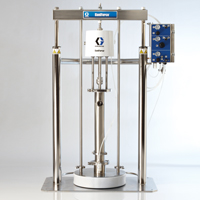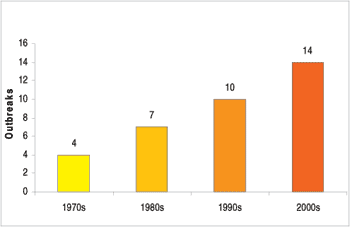
FSMA could spur food industry to greater achievement
With the new focus on food safety and traceability as well as how organizations handle these issues, food and beverage processors have much to learn from their counterparts in industries like high-tech, automotive and the life sciences, says the study. In these four major KPIs, the food and beverage industry lags noticeably behind middle performers.
For example, best-in-class performers (the top 20 percent) of all industries achieve 99 percent production compliance, 89 percent OEE scores, 98 percent on-time and complete shipments and four hours response time to non-conforming shipments. Industry average performers (all industries) achieve 97 percent production compliance, 77 percent OEE, 94 percent on-time and complete shipments and 16 hours response time to non-conforming shipments. However, food and beverage processors achieve 92 percent production compliance, 73 percent OEE, 88 percent on-time and complete shipments and 18 hours response time to non-conforming shipments, according to the study. See the graph (right).
The four KPIs provide a holistic measurement of success in any organization, but are especially telling when examining the success of a food safety and traceability initiative, says the study. Clearly the first and last metrics-production compliance and the speed of forward and backward traceability-directly affect food safety.
However, with such thin margins, it is essential that food safety not be improved at the expense of supply chain or operational efficiency. For this reason, OEE and complete and on-time shipments are also considered key metrics to ensure the best-in-class manufacturers are not achieving success at the expense of other business requirements.
The study expresses concern that food and beverage manufacturers are not doing as well as many would hope. This begs the question: In the area of product safety and traceability, what can the food and beverage industry learn from other industries that have been investing in these areas and in many ways are already more mature?
For food and beverage manufacturers seeking to achieve best-in-class performance, the study offers some recommendations to work toward this level of performance. They include:
- Establishing food safety and traceability as key items on the executive team’s agenda for focus and improvement.
- Building traceability and compliance into the production process with enablers such as automated SPC, HACCP, GMPs, CAPA (corrective action/preventive action) and more.
- Extending beyond the capabilities delivered by traditional ERP to deliver real-time supply chain visibility and traceability across suppliers, manufacturing, retailers and consumers.

Innovation means bigger return on sales
In response to the weakened economy, there was a large increase of manufacturers that introduced innovations. Innovation strategies, especially in the process, are associated with higher profitability and wages compared to low-price product strategies. More than half (51 percent) of all manufacturing companies introduced new processes to their facilities, says the study. In the food and textiles industries, 48.6 percent introduced new processes with the majority focused on techniques and technologies at 39 percent.
The survey also reviewed how food and textile manufacturers adopted the innovation that was introduced. More than three-fifths (61.8 percent) worked with customers on innovation while 49.8 percent also worked with their suppliers. The highest percentage of manufacturers that conducted market research to adopt new innovations was in the food and textiles sector at 25.2 percent.
As part of the survey, manufacturers were asked to rank six strategies based on their importance in competing for sales. More than half ranked high-quality products as first, followed by low price at 20 percent, adapting to customer needs (20 percent), quick delivery (9 percent), sustainable manufacturing (2 percent) and innovation/new technology (10 percent). Across all six strategies, results revealed manufacturers that pursued innovation strategies garnered the highest average return on sales-14 percent. Low price and quick-delivery strategies were linked to the lowest average return on sales (6 percent). While profits of

Is front-of-package labeling adequate?
According to the Food Marketing Institute, which helped create the system, the information will be presented in a “fact-based, simple and easy-to-use format,” with an icon informing consumers about how the key nutrients in each product fit into a balanced and healthy diet as part of the federal government’s daily dietary recommendations.
The Food and Drug Administration (FDA) has also been drafting its own system, and at least one lawmaker thinks the food industry should have waited for the regulations. Rep. Rosa DeLauro (D-CT) calls the industry move “troubling” and says it should not circumvent FDA efforts.
“Given that negative and positive nutrients will not be differentiated on the package, there is significant risk that these labels will be ignored,” DeLauro says. “An adequate labeling system must clearly alert consumers about potentially unhealthy foods, and should not mislead them into believing that some foods are healthy when they clearly are not.”
DeLauro urges the FDA to continue development of a federal front-of-package labeling system.Automation News

Automation Federation, IMS extend automation competency model
Through the ACMN, partners in non-US IMS regions and in other countries worldwide will be encouraged to adopt the ACM, adapting it as necessary to local circumstances and using it as the basis for developing training and education curricula as appropriate. This project will operate as an open network, and additional partners from IMS regions with expertise in automation competencies will be actively encouraged to participate.
Several IMS partners expressed their interest in being part of the ACM Network, and are joining the ACMN project, including Switzerland’s University of Applied Sciences and Arts of Southern Switzerland (SUPSI) Institute CIM for Sustainable Innovation (ICIMSI); Mexico’s Instituto Tecnológico de Estudios Superiores de Monterrey (ITESM); and Mexico’s government agency, ProMéxico.

Sanitary drum unloading systems can be lifesavers
Drum unloaders provide a safer way of emptying the drum’s contents, says Kellie Momchilovich, Graco Sanitary Equipment product manager. Drum unloaders are best suited for unloading highly viscous materials, and can also transfer tomato pastes and peanut butters, oils and syrups.
The typical evacuation time for a drum unloader is about five minutes vs. comparable manual processes that can take 30 minutes or more. Also, with manual processes, when water is introduced to the material, it typically needs to be removed at a later part in the process, which takes more time and can introduce contaminants into the product.
The drum unloader reduces residual product left in the bottom and sides of the drum, says Momchilovich. A high-performance drum unloader with an inflatable wiper seal will leave less than 1 percent residual product remaining in the bottom of the drum.
Pumps are a key part of the unloading system. “One of the most common pumps on a drum unloader is a sanitary, air-operated double-diaphragm pump,” says Momchilovich. A diaphragm pump unloading system can move materials with viscosities up to 100,000 cps. Typical materials a diaphragm pump unloader can handle are fruit juice concentrates, salad dressings, condiments and sauces.
For unloading materials with viscosities greater than 100,000 cps, one method is to use a sanitary piston pump on a drum unloader. Piston pumps are capable of higher pressures to move high-viscosity materials longer distances. Piston pumps come in ratios. For example, a 12:1 piston pump provides an outlet fluid pressure 12 times the pressure of the inlet air, up to 1,200 psi, says Momchilovich. This outlet fluid pressure coupled with the down pressure of the drum unloader’s ram plate allows the processor to unload highly viscous materials like peanut butter and caramel, applications that would be very difficult with a double-diaphragm pump.
There have been advancements in drum unloader technology, says Momchilovich. The first is the creation of the inflatable wiper seal technology on the ram plate. After the ram plate and seal enter the drum, the user flips a switch, which inflates the seal to the appropriate pressure. The seal holds this pressure and gently scrapes the side of the drum as the ram plate moves from top to bottom. This architecture can achieve greater than 99 percent evacuation rates.
Strides have also been made in improving “cleanability” of the drum unloader, says Momchilovich. Processors need equipment that is easy to take apart, clean and put back together. Quick-disconnect clamps are replacing bolted designs. Easy-to-repair air valves are replacing air valves with 30 or more parts, and PTFE over-molded diaphragms are replacing diaphragms with an exposed fluid-side diaphragm plate. PTFE diaphragms eliminate the potential for bacteria to harbor between the fluid-side diaphragm plate and the diaphragm.
Often, drums are different sizes and shapes. Ingredient suppliers are constantly changing the size and shape of their drums, from conical to straight-sided. Momchilovich advises processors to be sure the unloaders they purchase are future proof and can adapt to various sizes and shapes, especially if a drum resembles more of a cone than a cylinder. Finally, a drum unloader can be a big investment, but it can pay off in less than a year through labor savings, employee safety and food safety.
For more information, contact Kellie Momchilovich.
Field instrument update extends device "smarts"
The latest enhancements to EDDL include:
- Support for modular devices, such as I/O subsystems that can be populated with new I/O cards over time without having to upgrade system software
- Support for offline configuration with default parameter values suggested by the device manufacturer to simplify and speed up device commissioning
- Support for Unicode character sets to display parameter labels, diagnostics and device manufacturer expert help text in many different languages, including Japanese, Chinese, etc.
- Ability to display all device diagnostics from different blocks and all setup information on a single page, making devices easier to use and enabling commissioning and maintenance tasks to be completed faster
- Ability to display information based on prior selections and internal dependencies in the device, only presenting valid options so not to clutter the pages or “wizards” (methods) with irrelevant information or waste the technician’s time by prompting for information that will not be used or options that do not apply, and
- Ability to display illustrations based on the chosen language. For instance, this could include images with explanatory text conveying know-how from the device manufacturer to assist in the interpretation of advanced diagnostics and guide setup and troubleshooting.
EDDL is a text-based language for describing the digital communication characteristics of intelligent devices and equipment parameters in an operating system (OS) and human machine interface (HMI) neutral environment. EDDL assists engineers during distributed control system (DCS) configuration, technicians during commissioning and maintenance using device configuration software for laptop or handheld field communicators, and operators working at DCS consoles or using intelligent device management software as part of asset management solutions.
For more information about EDDL, visit www.eddl.org.Food Safety News

FDA's bigger budget request impacts FSMA

An alternative to FDA inspections would be states performing the legally mandated inspections, but the states would have to hire and/or train inspectors and manage the process, adds Cook. Another option would be the FDA’s acceptance of certified inspections by a third party using, for example, GFSI (Global Food Safety Initiative)-benchmarked standard audits.
FSMA has brought with it several questions regarding US processors’ compliance with Codex Alimentarius, especially if food is imported from the EU or exported to the members of the EU. The Codex Alimentarius Commission was created in 1963 by the United Nations’ FAO and WHO to develop food standards, guidelines and related texts such as codes of practice under the Joint FAO/WHO Food Standards Program.
“Codex is strictly a voluntary program and does not directly affect the laws in the
“USDA and US FDA worked closely with the other countries to formulate these Codex Standards,” says Cook. “Codex Standards will only increase the quality and safety of food in a country if the standard is adopted in full by that country.”
Under FSMA, electronic track-and-trace records will become crucial to safer food. While the use of RFID tags has helped make track and trace easier, it hasn’t been a total solution, partly because smaller processors can’t afford the necessary computer-based system, says Cook. And while FDA has a reporting system for contaminated food, it’s not the ultimate solution either. A cloud-based computer database system could serve the developed world that has access to computers, allowing vital information on products and shipments to be uploaded. But unfortunately, in much of the world where produce is grown and shipped, computers are nonexistent, and the cloud solution is terribly impractical, says Cook. “Under the FSMA, even the simple FDA [reporting] system will explode with information, with more personnel being required to report information on contaminants and recalls,” he adds.
While there has been considerable progress, we are still a long way off-from even having a domestic government-sponsored track and trace program, says Cook.
Antibiotics lose potency as bugs develop resistance
CSPI’s analysis shows a steady increase of such outbreaks in every decade since the 1970s, though that may be due to increased testing and reporting, says the CSPI researchers. In its study of 35 documented outbreaks, raw milk, raw milk cheeses and ground beef appeared to carry the resistant pathogens most frequently.
Multi-drug resistance was found in 10 out of 14 outbreaks of antibiotic-resistant foodborne illness reported between 2000 and 2009, according to the study. CSPI says the problem of antibiotic-resistant bacteria needs much greater scrutiny by the federal government if antibiotics are to remain effective in treating human and veterinary illnesses.
Cataloging outbreaks of foodborne illness and then testing the pathogens for antibiotic resistance is a critical step if policymakers are to document the link between antibiotic use on farm animals and human illness from antibiotic-resistant bacteria, says the study. Unfortunately, information on outbreaks of foodborne illness due to antibiotic-resistant bacteria is limited. Salmonella and E. coli are not routinely tested for antibiotic resistance, and even when tests are performed, results are not required to be reported to CDC.
CSPI researchers documented through literature searches a total of 35 foodborne outbreaks between 1973 and 2009 in which the bacteria identified were resistant to at least one antibiotic. The report illustrates the link between foods, mostly of animal origin, and outbreaks of antibiotic-resistant pathogens in humans. The report emphasizes this is not an “emerging problem, but an established problem” that needs more routine scrutiny by public health officials.
The National Antimicrobial Resistance Monitoring System (NARMS) collects data on patterns of emerging resistance from pathogens. The data is not linked to actual outbreaks. Also, CDC does not track and publish outbreaks on sporadic illnesses caused by resistant bacteria, as it does for pathogens in its FoodNet system. The CSPI study links together this information in a preliminary database to show what could be accomplished should a public health agency integrate the data.
A total of 19,897 people were sickened in 35 outbreaks during the 1970s through the 2000s. These illnesses resulted in 3,061 hospitalizations and 26 deaths. The data includes one large Salmonella Typhimurium outbreak caused by milk in 1985 in which 16,659 were sickened, 2,777 were hospitalized and 18 died.
For more information on antibiotic-resistant bacteria, references and a compendium of the data described above, download the CSPI study.
Industry associations endorse dietary guidelines
“Since 2002, GMA member companies have introduced more than 20,000 products with fewer calories and reduced fat, sugar and sodium,” the association says in a statement. “Through the Healthy Weight Commitment Foundation, food and beverage companies have pledged to remove 1.5 trillion calories from the food supply by 2015.”
GMA says the guidelines will be especially helpful by focusing on calorie balance for weight management and nutrient-dense eating patterns as important concepts in helping Americans build a healthy lifestyle.
The Dairy Foods Association also voices strong support for the guidelines, noting it encourages three daily servings of low-fat or fat-free milk and milk products for adults as well as children nine years and older.